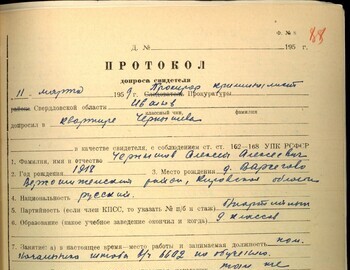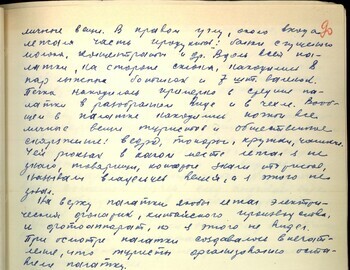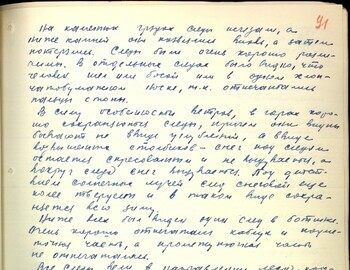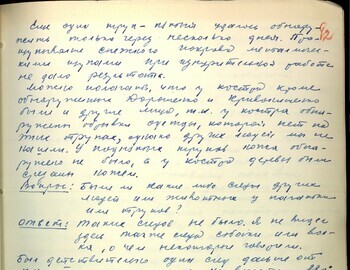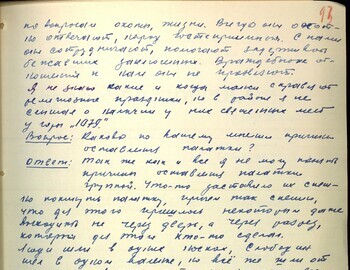
Chernyshev witness testimony
Protocol
witness testimony
On March 11, 1959 the public prosecutor-investigator of the Sverdlovsk region Ivanov questioned in Chernyshev's apartment as a witness, in compliance with art. 162-168 Code of Criminal Procedure
- Surname, name and middle name: Chernyshev Aleksey Alekseevich
- Year of birth 1918
- Place of birth: village of Varsegovo Verhonizhenskiy district, Kirov region
- Nationality: Russian.
- Political affiliation: none
- Education: 9th grade
- Occupation a) currently - place of work and occupation: assistant Chief of Staff in army unit 6602 in charge of the training. b) at the moment of the events: the same, Captain.
- Criminal record: no
- Permanent residence: Ivdel, Pavlik Morozov St, 26
- Passport: -
- Relation to the accused: -
Warned on the responsibility of the first part of Art. 92 of the RSFSR Criminal Code for refusing to testify and under Art. 95 RSFSR Criminal Code for knowingly giving false testimony.
Chernyshev (signature)
The witness testified: On 25.II-59 at 7 pm the commander of our unit Busygin came to me and we went together to the restaurant at the hotel. On the way there he told me that I have to lead a search party to look for the missing hikers.
At the hotel were already many people that I didn't till then: Colonel Ortyukov, Maslennikov, Vishnevskiy, etc. We began to discuss the search operation. My role was to gather 5-6 people and be ready to fly at 1 pm on 26.II-59 to the area of Dyatlov group route.
In my group were: Captain Vlasov, Petty Officer Sidorov, Staff Sergeant Verhovskiy and a civilian Yablonsky. For all these comrades this wasn't their first time in the forest, they are all hunters and trackers. We took food supplies for 7 days.
The group task was to find traces of Dyatlov group. We were supposed to land in the upper reaches of Purma river, about 25 km from the top of "1079", go over the pass and explore the upper reaches of Vishera river. After that to move along the ridge strictly south. In the upper Vishera we were supposed to meet with Slobtsov group. We flew out on 26.II-59 and landed in a designated area of the route. On the second day a canister was dropped from a plane with change of plan. The information inside was that Dyatlov tent and two bodies were found in the area of the height "1079". We were given instructions to move towards heights "1079" and "880", we were
25 km from there. We didn't see any tracks the the area where we were dropped. Approximately 4 pm on 27.II the helicopter found us, we boarded and landed in the area where Dyatlov tent was. There was a group of tents already Slobtsov, Karelin, as well as Maslennikov.
On this day Moiseev with dogs went out on a search and found the bodies of Kolmogorova and Dyatlov.
On the second day were dispatched search groups, and I went with prosecutor Tempalov and up to 10 people to start the excavation of the tent.
The tent was found on the slope of the height "1079", 100-150 m north-east from the top. At first glance, the tent seemed snowbound, but when we looked at it closer, we saw that the tent entrance was supported by the central peg and was well fortified with ropes. The other edge were also kept at their poles, but because the middle of the tent was piled up with snow, and the slopes of the tents on the windward side were severely damaged, the edge had fallen and was under the snow.
It was impossible to get into the tent, as all of it was covered with snow, and the layout of the items inside was revealed only after digging it up. The tent was set properly. The snow was trampled, on the snow were lying the skis with their sliding surface up, on top of them was the floor of the tent. At the very bottom of the tent were laid jackets (on the side of the slope), empty backpacks were spread on the bottom. At the same side of the tent (the slope) each lay their
personal belongings. In the right side of the entrance were found the products: cans with condensed milk, concentrates, etc. along the tent on the side of the slope were 8 pairs of shoes, and 7 pairs of felt boots (valenki). The stove was located approximately in the middle of the tent in a disassembled state in its case. Almost all personal belongings of hikers and university equipment: bucket, axes, mugs, bowls. Whose backpack was lying where I couldn't tell, comrades, who knew them called the owners of things, but I wasn't familiar.
At the top of the tent allegedly was lying Chinese flashlight, and a camera, but I didn't see it. On examination, the impression was that the hikers left the tent orderly.
Dyatlov tent was located on the north-east slope of the mountain "1079", and the slope going down passed into the ravine. The slope had uneven lowering traversed across by several stone ridges running parallel.
Starting 30-40 m from the tent were found well preserved, clearly distinguishable traces of human feet. The traces stretched in parallel tracks close to each other, as if people were holding on to each other. Footprints stretched in kind of two directions - we counted on the tent down to the valley 6 or 7 pairs of tracks, and 20 m to the left of them went 2 more pair of tracks. Then in 30-40 m these two groups (2 and 7 tracks) came together and do not part.
Traces disappeared on the stone ridges, and below the stones they appeared again, and then were lost. The tracks were very well distinguished. In some footprints could be seen that the person was walking barefoot or in cotton sock, because the toes were imprinted.
Due to peculiarities of the winds in the mountains the tracks were well preserved, and they are not visible in the form of depressions but elevations in the form of bars - the snow is compressed under the track and not blown out, and the snow is blown around the tracks. Under the exposure of sunlight the snow tracks further harden and they are stored in this form through the winter. Further down was visible one track in a boot. Very well etched heel and the heel portion, and the intermediate part is not printed.
All the tracks were in direction of the forest, which began on the right side of the ravine. There subsequently were found the bodies. I did not discover the bodies, but I have approached each of them.
In one and a half kilometers away from the tent down the hill stands a cedar. 20 m before the cedar was a fir tree cut with a knife. 6-7 fir trees were cut down apparently to ignite or maintain the fire. Next to the cedar was a makeshift fire and there were two bodies. The fire had burned the branches as thick as 8-10 cm. At the bottom of the cedar branches were broken off completely as high as a person can reach. Also one branch was broken at a height of 4-5 m. The broken branches were thick, this could be accomplished only, for example, you hang on them with your whole body.
A fifth body was found only a few days later. Working the snow with metal probes didn't yield results.
It can be assumed that at the fire besides Doroshenko and Krivonischenko there were other people since scraps of clothing were found not on the bodies, but we didn't find other people. No knifes were found on the bodies but the branches for the campfire were cut with a knife.
Question: Were there any other traces human or animal around the bodies or the tent?
Answer: There were no traces. I have not seen dog or wolf tracks, as some said. Was really one track further from the tent, about the stones on the top. But it was left by our search dogs.
Question: In this specific conditions could someone have come to the tent without leaving traces, in particular, do Mansi leave traces?
Answer: If Mansi came there on their skis, there wouldn't be any traces left. Their skis do not leave traces. The slope above the tent is bare.
Q: Do you consider the idea of an attack on the group by Mansi?
A: I do not concede this idea. For many years, I do not know a single case of an attack by Mansi on people. By the nature of my service I had to meet with Mansi all the time on various of occasions, and I had to talk to them
on topics about hunting, life. They are very agreeable, hospitable people. They work with us to help detain the escapees. They have never appeared hostile towards us. I do not know what and when Mansi celebrate religious holidays, but I have not heard that there have sacred places in the area of "1079".
Q: What are in your opinion the reasons for the abandonment of the tent?
Answer: Just like everybody I don't understand the reasons for leaving the tent. Something made them flee the tent, and so abruptly, that some of them didn't even go through the entrance, but through the incision, which someone made. People were walking in socks, Slobodin had one felt boot, but everybody went out of the tent. Maybe they were driven by the wind, but they were not rolled in the snow - in this case, there would be any traces.
Question: Have you ever used to be in these places, what is the weather in the area?
A: I haven't been previously in that area, but I know that the weather there is very unstable, frequent winds that blow with hurricane force. I spent 12 days in the camp and in this period were only two quiet days, and that is relatively quiet. Usually the power of the wind on the pass exceeds 15-20 m/s.
I have personally read the protocol, recorded correctly.
Chernyshev (signature)
Attorney forensic Jr Counselor of Justice L. Ivanov (signature)

